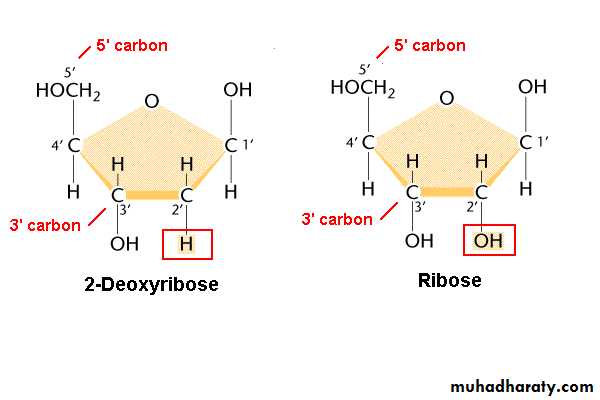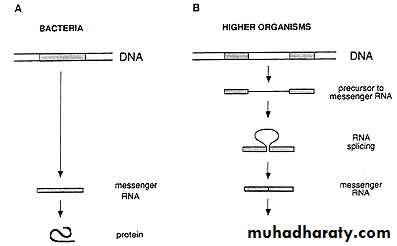Microbial Genetics
What is the geneticsWhat is the gene
DNA as the fundamental element of heredity
According to seminal experiment performedNucleic acids structure
• Nucleic acids are large polymers consisting of repeating nucleotide units.
• Each nucleotide contains one phosphate group, one pentose or deoxypentose sugar, and one purine or pyrimidine base.• In DNA the sugar is D-2-deoxyribose; in RNA the sugar is D-ribose.
• In DNA the purine bases are adenine (A) and guanine (G), and the pyrimidine bases are thymine (T) and cytosine (C).
• The repeating structure of polynucleotides involves alternating sugar and phosphate residues, with phosphodiester bonds linking the 3'-hydroxyl group of one nucleotide sugar to the 5'- hydroxyl group of the next nucleotide sugar. A purine or pyrimidine base is linked at the 1'-carbon atom of each sugar group and projects from the repeating sugar-phosphate backbone.
• dsDNA is helical, and the two strands in the helix are antiparallel. The double helix is stabilized by hydrogen bonds between purine and pyrimidine bases on the opposite strands.
Ribonucleic acid (RNA)
What is RNA, typesThe Eukaryotic Genome
2- Mitochondria and Chloroplasts DNA3- Many yeast contain an additional genetic element, called as plasmids
1-Eukaryotic genome is carried on two or more linear chromosomes
The Prokaryotic Genome
1- Bacterial chromosome2- (>90%) of prokaryote genome consist of a single circular DNA molecule.
A few bacteria (eg, Brucella,, Burkholderia, and Vibrio cholerae) have genomes consisting of two circular DNA molecules.
3- Many bacteria contain additional genes on plasmids that range in size from several to 100 kbp.
*** 98% of bacterial genomes are coding sequences. ????
• Some bacterial species are causing disease in higher organisms because they possess specific genes that are clustered together in the DNA and are referred to as pathogenicity islands.
• Transposons are genetic elements that contain several genes, including those necessary for their migration from one genetic locus to another.
The short transposons called insertion elements, produces the majority of insertion mutations.
Replication
Bidirectional replication
semiconservative replicationFunction
• Enzyme
• Unzipping the DNA helix
Helicase• Synthesizing an RNA primer
Primase
• Adding bases to the new DNA chain; proofreading the chain for mistakesDNA polymerase III
• Removing RNA primers, replacing gaps between Okazaki fragments with correct nucleotides, repairing mismatched basesDNA polymerase I
• Final binding of nicks in DNA during synthesis and repairLigase
• SupercoilingGyrase
Gene expression
1- RNA polymerase forms a single polyribonucleotide strand, called mRNA, using DNA as a template; this process is called transcription. The template strand in the DNA double helix if read in the 3′–5′ direction. Thus, an mRNA is oriented in a 5′–3′ direction.
2- Amino acids are enzymatically activated and transferred to specific adapter molecules of RNA, called tRNA. Each adapter molecule has a triplet of bases (anticodon).
3- mRNA and tRNA come together on the surface of the ribosome. As each tRNA finds its complementary nucleotide triplet on mRNA, the amino acid that it carries is put into peptide linkage with the amino acid of the preceding tRNA molecule.
Start code of mRNA is AUG coded to methionine a.a
Stop codes are UGA, UAA, UAG
Mechanisms of Gene Transfer
Three broad mechanisms mediate efficient movement of DNA between cells:conjugation,
transduction,
and transformation.
Recombination refers to the acquisition of new segments of DNA from the local environment or by another microorganism.
DNA can be transferred from one organism to another, and that DNA can be stably incorporated in the recipient, permanently changing its genetic composition called horizontal gene transfer (HGT)
The transfer of only the of parental genes from parent cell o offspring, a process called vertical gene transfer (VGT).
Conjugation
• is a one-way transfer of genetic material (usually plasmids) from donor to recipient by means of physical contact. Conjugation requires donor cell to-recipient cell contact to transfer only one strand of DNA.
• F plasmid
• R factor
Transduction
phage-mediated genetic recombination in bacteria. DNA is carried by a phage coat and is transferred into the recipient cells.
Transformation
The direct uptake of donor DNA by the recipient cell, may be natural or forced.
Mutation
is the permanent alteration of the nucleotide sequence of the genome of an organism, virus, or extrachromosomal DNA or other genetic elements.
The spontaneous mutation is a random change in the DNA arising from errors in replication that occur without a known cause.
Induced mutations result from exposure to known mutagens, which are primarily physical or chemical agents that damage DNA and interfere with its functioning
Nucleotide substitutions
Results from mutagenic activity or the mis-pairing of complementary bases during DNA replication. It's often do not significantly disrupt the function of gene products.Frameshift mutations
result from the insertion or deletion of one or two base pairs, disrupting the phase of the triplet-encoded DNA message.
Deletions
are usually large excisions of DNA, dramatically altering the sequence of coded proteins. It may also result in frameshift mutations.Insertions
change genes and their products by integration of new DNA via transposons.
Rearrangements are the result of deletions that remove large portions of genes or even sets of genes.
• The genetic systems (genome) of different living things
StructureVirus
Bacteria
Fungus
Plant
Animal
Human
Nucleus
• -
• -
• +
• +
• +
• +
Nuclear membrane
• -
• -
• +
• +
• +
• +
chromosome
genome
single
multiple
multiple
multiple
multiple
Extra chromosome
• --
Plasmid
Mitochondria
plasmid
chloroplast
mitochondria
mitochondria
mRNA
mature
mature
immature
immature
immature
immature
DNA
• +/-
• +
• +
• +
• +
• +
Intron
• -
• -
• +
• +
• +
• +
Histone
• -
• -
• +
• +
• +
• +
Genetic Engineering
























